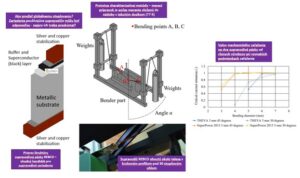Effect of mechanical stress on the properties of superconducting REBCO conductors

Low-loss devices are needed tackle global warming issues. Devices using superconducting conductors represent possible solutions for these goals. Our colleagues have recently presented a method to characterize the effect of mechanical stress on the electromagnetic properties of superconductors.
Low-losses devices and green energy solutions are a necessity to prevent global warming. Devices using superconductors could be such a solution. Superconductivity is a special state of the material at specific criteria, where the material can conduct very high electric current in very high-magnetic fields with very low or almost zero losses when cooled down to low temperatures (<-145° C). Often mentioned superconducting devices are low-loss high-voltage superconducting cables or superconducting magnets, which are used in the construction of fusion reactors. In both cases, an optimal design is essential, which requires a complex characterization of superconductors.
Superconductor Rare Earth Barium2 Copper3 Oxide7-δ (REBCO) is a suitable candidate for these devices. Superconductor REBCO is manufactured as a rectangular multi-layer composite in the form of a tape, where the superconducting layer often represents less than 5% of its cross-section. On the bottom and top sides of this thin superconducting ceramic layer are added metallic layers, which provide electric, thermal and mechanical stabilization and support. The electromagnetic properties of these tapes are well studied, however the influence of mechanical loading on these properties is less explored. In addition, superconducting tapes are improving each year, which means that their structure undergoes slight changes, requiring repeated characterization. Our colleauges from the Department of Applied Superconductivity recently proposed a characterization method of these properties, with an emphasis on simple construction design and repeatability of measurements. First, current leads and voltage taps of the measurement devices are soldered to the REBCO tape. Afterward, the whole measurement device is submerged into a liquid nitrogen bath (77 K), to reach the necessary temperature, where the REBCO tape is superconductive. Reference critical electrical current of the REBCO tape is measured under these conditions. Then, a body with a circular profile with a specific diameter is pushed into the tape at a certain angle. The critical current of the tape is re-measured, while the tape is under mechanical load. If it did not change, we lower the diameter of the circular body and repeat the measurement until we find a diameter at which the critical current of the specific REBCO tape lowers. Influence of the initial measurement parameters is verified by analytical and numerical calculations, which enables high repeatability of measurements under the same conditions. We observed from the measurements behaviour of two tapes from different manufacturers – when we applied the mechanical loading at different angles, we saw that it did not have an influence on one tape, but the second tape had angular dependence. If we adjust the angle at which the tape is used in devices, we can design optimal conditions for tape with such behaviour. The simplicity of the method should allow us to obtain the necessary knowledge about the behaviour of these tapes under the influence of mechanical loading and find the respective limits of specific tapes. These findings should accelerate the construction of the aforementioned superconducting cables or fusion reactors and help prevent global warming.

DOI: 10.1109/TASC.2023.3242924
Authors: T. Kujovič, R. Ries, M. Mošať, F. Gömöry
 Contact
Contact Intranet
Intranet SK
SK

